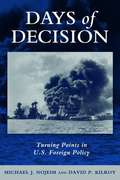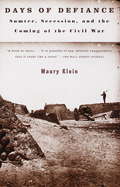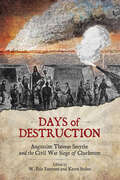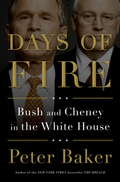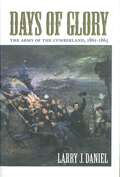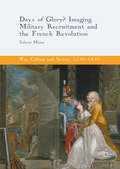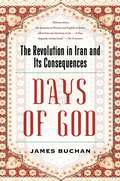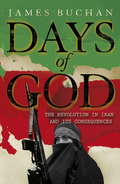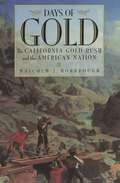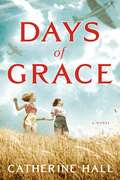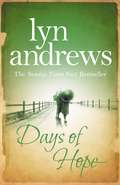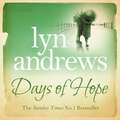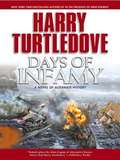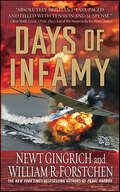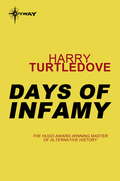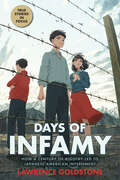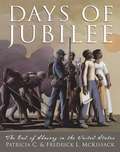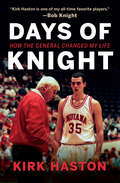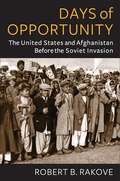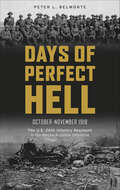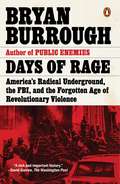- Table View
- List View
Days of Decision: Turning Points in U. S. Foreign Policy
by Michael J. Nojeim David P. KilroyDays of Decision spans a century of American foreign policy making, from the Spanish- American War of 1898 to the attacks of September 11, 2001. Michael J. Nojeim and David P. Kilroy carefully examine twelve foreign-policy landmarks, each of which played a crucial role in shaping world history and led to profound changes in U. S. foreign policy. Devoting one chapter to each turning point, they place it in its proper historical context, explore its political consequences--primarily the debates and divisions that arose among policymakers--and discuss the aftermath, focusing on its lasting influence on world affairs and the conduct of American diplomacy and foreign affairs. This accessible, introductory text provides students of foreign policy and international relations a deeper understanding of these disciplines' processes and of America's place in the world.
Days of Defiance
by Maury KleinWith a masterful eye for the telling detail, Klein vividly recounts the period from the election of Abraham Lincoln to the shelling of Fort Sumter. of photos. 2 maps.
Days of Destruction: Augustine Thomas Smythe and the Civil War Siege of Charleston
by W. Eric Emerson and Karen StokesOne Confederate soldier’s descriptive letters to his family offering a personal view of the devastating Civil War assault.In Days of Destruction, editors W. Eric Emerson and Karen Stokes chronicle the events of the siege of Charleston, South Carolina, through a collection of letters written by Augustine Thomas Smythe, a well-educated young man from a prominent Charleston family. The vivid, eloquent letters he wrote to his family depict all that he saw and experienced during the long, destructive assault on the Holy City and describe in detail the damage done to Charleston’s houses, churches, and other buildings in the desolated shell district, as well as the toll on human life.Smythe’s role in the Civil War was different from that of his many companions serving in Virginia and undoubtedly different from anything he could have imagined when the war began. After a baptism in blood at the Battle of Secessionville, South Carolina, Smythe was assigned to the Confederate Signal Corps. He served on the ironclad CSS Palmetto State and then occupied a post high above Charleston in the steeple of St. Michael’s Episcopal Church. From behind a telescope in his lofty perch, he observed the fierce attacks on Fort Sumter, the effects of the unrelenting shelling of the city by enemy guns at Morris Island, and the naval battles and operations in the harbor, including the actions of the Confederate torpedo boats and the H. L. Hunley submarine.The Confederate Signal Corps played a vital role in the defense of Charleston and its environs, and Smythe’s letters, perhaps more than any other first-person account, detail the daily life and service experiences of signalmen in and around the city during the war. For more than eighteen months, Smythe’s neighborhood south of Broad Street, one of the city’s oldest and wealthiest communities, was abandoned by the great majority of its residents. His letters provide the reader with an almost postapocalyptic perspective of the oftentimes quiet, and frequently lawless, street where he lived before and during the siege of Charleston.“A well-edited compilation of wartime correspondence that gives insight into a military and a city caught in a cataclysmic struggle for survival. It belongs on the bookshelves of all Civil War historians.” —Journal of Southern History“A valuable read for anyone interested operations around Charleston and the Home Front, and for its brief look at the very neglected Confederate Signal Corps.” —New York Military Affairs Symposium Review
Days of Fire: Bush and Cheney in the White House
by Peter BakerIn Days of Fire, Peter Baker, Chief White House Correspondent for The New York Times, takes us on a gripping and intimate journey through the eight years of the Bush and Cheney administration in a tour-de-force narrative of a dramatic and controversial presidency.Theirs was the most captivating American political partnership since Richard Nixon and Henry Kissinger: a bold and untested president and his seasoned, relentless vice president. Confronted by one crisis after another, they struggled to protect the country, remake the world, and define their own relationship along the way. In Days of Fire, Peter Baker chronicles the history of the most consequential presidency in modern times through the prism of its two most compelling characters, capturing the elusive and shifting alliance of George Walker Bush and Richard Bruce Cheney as no historian has done before. He brings to life with in-the-room immediacy all the drama of an era marked by devastating terror attacks, the Iraq War, Hurricane Katrina, and financial collapse. The real story of Bush and Cheney is a far more fascinating tale than the familiar suspicion that Cheney was the power behind the throne. Drawing on hundreds of interviews with key players, and thousands of pages of never-released notes, memos, and other internal documents, Baker paints a riveting portrait of a partnership that evolved dramatically over time, from the early days when Bush leaned on Cheney, making him the most influential vice president in history, to their final hours, when the two had grown so far apart they were clashing in the West Wing. Together and separately, they were tested as no other president and vice president have been, first on a bright September morning, an unforgettable "day of fire" just months into the presidency, and on countless days of fire over the course of eight tumultuous years. Days of Fire is a monumental and definitive work that will rank with the best of presidential histories. As absorbing as a thriller, it is eye-opening and essential reading.
Days of Glory: The Army of the Cumberland, 1861–1865
by Larry J. DanielA potent fighting force that changed the course of the Civil War, the Army of the Cumberland was the North's second-most-powerful army, surpassed in size only by the Army of the Potomac. The Cumberland army engaged the enemy across five times more territory with one-third to one-half fewer men than the Army of the Potomac, and yet its achievements in the western theater rivaled those of the larger eastern army. In Days of Glory, Larry J. Daniel brings his analytic and descriptive skills to bear on the Cumberlanders as he explores the dynamics of discord, political infighting, and feeble leadership that stymied the army in achieving its full potential. Making extensive use of thousands of letters and diaries, Daniel creates an epic portrayal of the developing Cumberland army, from untrained volunteers to hardened soldiers united in their hatred of the Confederates.
Days of Glory?: Imaging Military Recruitment and the French Revolution (War, Culture and Society, 1750-1850)
by Valerie MainzThis book examines a range of visual images of military recruitment to explore changing notions of glory, or of gloire, during the French Revolution. It raises questions about how this event re-orientated notions of 'citizenship' and of service to 'la Patrie'. The opening lines of the Marseillaise are grandly declamatory: Allons enfants de la Patrie/le jour de gloire est arrivé! or, in English: Arise, children of the Homeland/The day of glory has arrived! What do these words mean in their later eighteenth-century French context? What was gloire and how was it changed by the revolutionary process? This military song, later adopted as the national anthem, represents a deceptively unifying moment of collective engagement in the making of the modern French nation. Valerie Mainz questions this through a close study of visual imagery dealing with the issue of military recruitment. From neoclassical painting to popular prints, such images typically dealt with the shift from civilian to soldier, focusing on how men, and not women, were called to serve the Homeland.
Days of God
by James BuchanA myth-busting insider's account of the Iranian Revolution of 1979 that destroyed US influence in the country and transformed the politics of the Middle East and the world. James Buchan was studying in Iran in the 1970s when the turmoil that culminated in the revolution began. Fluent in Persian, he draws on a wealth of Iranian records, memoirs, diaries and newspaper reports and his own knowledge and experience to provide the first comprehensive history of that tumultuous time. Buchan explores the roots of the revolution in the Shah's regime and and explains how, even as the Iranian economy flourished and the country asserted its new power, beneath the surface deep anxieties were coming to a head. He shows how Ayatollah Khomeini, at first just one actor in the anti-Shah movement, by force of will came to dominate it. Buchan recounts the see-saw violence and passions that gripped the country and reached fever pitch when Khomeini returned from exile in February, 1979, launching a reign of terror that demolished opposition to his rule. He shows how the chaos in Iran provoked a re-alignment of forces in the Middle East, from the Soviet invasion of Afghanistan to the rise of Saddam Hussein's Iraq and the development of Al-Qaida. A dramatic, scene-by-scene account with rich characterizations of the leading players as well as of the ordinary Iranians who were swept into the maelstrom, Days of God is history-writing at its vivid best.
Days of God: The Revolution in Iran and Its Consequences
by James BuchanA myth-busting insider's account of the Iranian Revolution of 1979 that destroyed US influence in the country and transformed the politics of the Middle East and the world. The 1979 Islamic revolution in Iran was one of the seminal events of our time. It inaugurated more than thirty years of war in the Middle East and fostered an Islamic radicalism that shapes foreign policy in the United States and Europe to this day. Drawing on his lifetime of engagement with Iran, James Buchan explains the history that gave rise to the Revolution, in which Ayatollah Khomeini and his supporters displaced the Shah with little difficulty. Mystifyingly to outsiders, the people of Iran turned their backs on a successful Westernized government for an amateurish religious regime. Buchan dispels myths about the Iranian Revolution and instead assesses the historical forces to which it responded. He puts the extremism of the Islamic regime in perspective: a truly radical revolution, it can be compared to the French or Russian Revolutions. Using recently declassified diplomatic papers and Persian-language news reports, diaries, memoirs, interviews, and theological tracts, Buchan illuminates both Khomeini and the Shah. His writing is always clear, dispassionate, and informative. The Iranian Revolution was a turning point in modern history, and James Buchan's Days of God is, as London's Independent put it, "a compelling, beautifully written history" of that event.
Days of God: The Revolution in Iran and Its Consequences
by James BuchanThe Iranian Revolution of 1979 was a turning-point in modern history. The destruction of the Iranian monarchy not only upset the political order in the Middle East and brought on a quarter-century of warfare, but introduced a new way to look at history. In Days of God James Buchan lives each moment of the revolution through the eyes of ordinary people as he tries to answer his own troubling question: why did his friends, with their peculiar Iranian dreaminess and charm, act the way they did?
Days of Gold: A Novel (Edilean Series #2)
by Jude DeverauxThe New York Times bestselling author of The Summerhouse brings her signature &“marvelously compelling&” (Houston Chronicle) prose to the second historical romance in the charming Edilean series.Angus McTern is respected by the men of his clan and adored by the women. He takes his duties as laird seriously and has everything he wants in life—until Edilean Talbot shows up. Breathtakingly beautiful and born of privilege, Edilean needs Angus&’s help to reclaim the gold she inherited from her father. Unfortunately, when Angus tries to seize it, he&’s accused of theft, and has to leave behind all that he knows and escape with Edilean to the New World. There they discover almost insurmountable obstacles, and a love as wild and free as the land itself. Stirring and masterfully rendered, Jude Deveraux &“incorporates her trademark sweet and salty characters into a pair of entertaining romances, one past, one present, to create one of her most fun and pleasing tales&” (Booklist).
Days of Gold: The California Gold Rush and the American Nation
by Malcolm J. RohrboughOn the morning of January 24, 1848, James W. Marshall discovered gold in California. The news spread across the continent, launching hundreds of ships and hitching a thousand prairie schooners filled with adventurers in search of heretofore unimagined wealth. Those who joined the procession—soon called 49ers—included the wealthy and the poor from every state and territory, including slaves brought by their owners. In numbers, they represented the greatest mass migration in the history of the Republic.In this first comprehensive history of the Gold Rush, Malcolm J. Rohrbough demonstrates that in its far-reaching repercussions, it was the most significant event in the first half of the nineteenth century. No other series of events between the Louisiana Purchase and the Civil War produced such a vast movement of people; called into question basic values of marriage, family, work, wealth, and leisure; led to so many varied consequences; and left such vivid memories among its participants.Through extensive research in diaries, letters, and other archival sources, Rohrbough uncovers the personal dilemmas and confusion that the Gold Rush brought. His engaging narrative depicts the complexity of human motivation behind the event and reveals the effects of the Gold Rush as it spread outward in ever-widening circles to touch the lives of families and communities everywhere in the United States. For those who joined the 49ers, the decision to go raised questions about marital obligations and family responsibilities. For those men—and women, whose experiences of being left behind have been largely ignored until now—who remained on the farm or in the shop, the absences of tens of thousands of men over a period of years had a profound impact, reshaping a thousand communities across the breadth of the American nation.
Days of Grace
by Catherine HallAn intense wartime friendship and a corrosive secret that is kept for decades are at the center of this suspenseful novel of repressed passion and World War II tragedy.
Days of Hope: Even after the war, hearts can still be broken…
by Lyn AndrewsThe war may be over, but their troubles have only just begun... Days of Hope by bestselling author Lyn Andrews is a heart-warming saga set in 1940s Liverpool and Ireland, about the hurdles two sisters must cross on their journey to finding the happiness they seek. Perfect for fans of Anne Baker, Katie Flynn and Dilly Court.It's 1945 and the war is finally over. For the Devlin family in Liverpool, the wartime years have been almost too much to bear. But at long last sisters Grace and Chrissie can return to their normal lives. Level-headed and hard-working, Grace wants nothing more than to meet a nice man and settle down. Vivacious Chrissie, though, craves fun and excitement - and there's not much of that to be had in the austere post-war years. So when Chrissie meets Pat Kilroy, a handsome Irishman, she's swept off her feet and eagerly follows Pat to Ireland. Chrissie soon realises she has made a terrible mistake, and Grace rushes to her side to help. But the consequences of Chrissie's actions are to be as far-reaching as they are devastating. What readers are saying about Days of Hope: 'All of Lyn's books are easy to read and are entertaining but this story is by far the best. Days of Hope is excellent and the characters are very well written''I started this book Thursday night and finished it Saturday afternoon. This is a very good book, fast paced and easy to read'
Days of Hope: Even after the war, hearts can still be broken…
by Lyn AndrewsIt's 1945 and the war is finally over. For the Devlin family in Liverpool, the wartime years have been almost too much to bear. But at long last sisters Grace and Chrissie can return to their normal lives. Level-headed and hard-working, Grace wants nothing more than to meet a nice man and settle down. Vivacious Chrissie, though, craves fun and excitement - and there's not much of that to be had in the austere post-war years. So when Chrissie meets Pat Kilroy, a handsome Irishman, she's swept off her feet and eagerly follows Pat to Ireland. Chrissie soon realises she has made a terrible mistake, and Grace rushes to her side to help. But the consequences of Chrissie's actions are to be as far-reaching as they are devastating.(P)2012 Headline Digital
Days of Infamy
by Harry TurtledoveOn December 7, 1941, the Japanese launched an attack against United States naval forces stationed in Pearl Harbor, Hawaii. But what if the Japanese followed up their air assault with an invasion and occupation of Hawaii? With American military forces subjugated and civilians living in fear of their conquerors, there is no one to stop the Japanese from using the islands' resources to launch an offensive against America's western coast.
Days of Infamy (The Pacific War Series)
by Newt Gingrich William R. ForstchenNew York Times bestselling authors Newt Gingrich and William R. Forstchen return with the second novel in their World War II Pacific Theater series.Gingrich and Forstchen's now critically acclaimed approach, which they term "active history," examines how a change in but one decision might have profoundly altered American history. In Pearl Harbor they explored how history might have been changed if Admiral Yamamoto had directly led the attack on that fateful day, instead of remaining in Japan. Building on that promise, Days of Infamy starts minutes after the close of Pearl Harbor, as both sides react to the monumental events triggered by the presence of Admiral Yamamoto. In direct command of the six carriers of the attacking fleet, Yamamoto decides to launch a fateful "third-wave attack" on the island of Oahu, and then keeps his fleet in the area to hunt down the surviving American aircraft carriers, which by luck and fate were not anchored in the harbor on that day.Historians have often speculated about what might have transpired from legendary "matchups" of great generals and admirals. In this story of the aftermath of Pearl Harbor, the notorious gambler Yamamoto is pitted against the equally legendary American admiral Bill Halsey in a battle of wits, nerve, and skill.Days of Infamy recounts this alternative history from a multitude of viewpoints---from President Roosevelt, Prime Minister Churchill, and the two great admirals, on down to American pilots flying antiquated aircraft, bravely facing the vastly superior Imperial Japanese Navy aircraft. Gingrich and Forstchen have written a sequel that's as much a homage to the survivors of the real Pearl Harbor attack as it is an imaginative and thrilling take on America's entry into World War II.
Days of Infamy: A Novel Of Alternate History
by Harry TurtledoveJapanese Zeros appear in the skies over Hawaii and descend upon Pearl Harbor in a devastating attack that cripples the U.S. Navy fleet and airfields. One after another, the islands are conquered and occupied by the Empire of the Sun. In the hands of a merciless enemy, American soldiers in POW camps suffer cruel punishment. Many older Hawaiians of Japanese origin support the invaders - while some of their children want to fight back. But the domination of the Pacific and the submission of those who live there is merely the beginning. With the U.S. military on Hawaii completely subjugated, there is no one to stop the Japanese from using the islands' resources to launch an offensive against America's western coast...
Days of Infamy: How a Century of Bigotry Led to Japanese American Internment (Scholastic Focus)
by Lawrence GoldstoneIn another unrelenting look at the iniquities of the American justice system, Lawrence Goldstone, acclaimed author of Unpunished Murder, Stolen Justice, and Separate No More, examines the history of racism against Japanese Americans, exploring the territory of citizenship and touching on fears of non-white immigration to the US -- with hauntingly contemporary echoes.On December 7, 1941 -- "a date which will live in infamy" -- the Japanese navy launched an attack on the American military bases at Pearl Harbor, Hawaii. The next day, President Franklin Roosevelt declared war on Japan, and the US Army officially entered the Second World War.Three years later, on December 18, 1944, President Roosevelt signed Executive Order 9066, which enabled the Secretary of War to enforce a mass deportation of more than 100,000 Americans to what government officials themselves called "concentration camps." None of these citizens had been accused of a real crime. All of them were torn from their homes, jobs, schools, and communities, and deposited in tawdry, makeshift housing behind barbed wire, solely for the crime of being of Japanese descent. President Roosevelt declared this community "alien," -- whether they were citizens or not, native-born or not -- accusing them of being potential spies and saboteurs for Japan who deserved to have their Constitutional rights stripped away. In doing so, the president set in motion another date which would live in infamy, the day when the US joined the ranks of those Fascist nations that had forcibly deported innocents solely on the basis of the circumstance of their birth.In 1944 the US Supreme Court ruled, in Korematsu v. United States, that the forcible deportation and detention of Japanese Americans on the basis of race was a "military necessity." Today it is widely considered one of the worst Supreme Court decisions of all time. But Korematsu was not an isolated event. In fact, the Court's racist ruling was the result of a deep-seated anti-Japanese, anti-Asian sentiment running all the way back to the California Gold Rush of the mid-1800s. Starting from this pivotal moment, Constitutional law scholar Lawrence Goldstone will take young readers through the key events of the 19th and 20th centuries leading up to the fundamental injustice of Japanese American internment. Tracing the history of Japanese immigration to America and the growing fear whites had of losing power, Goldstone will raise deeply resonant questions of what makes an American an American, and what it means for the Supreme Court to stand as the "people's" branch of government.
Days of Jubilee: The End of Slavery in the United States
by Patricia C. Mckissack Fredrick L. MckissackIn this spirit-stirring journey, illustrated with stunning black-and-white photos, the McKissacks draw from slave narratives, letters, and diaries to document the days and weeks leading to freedom.
Days of Knight: How the General Changed My Life (Encounters: Explorations in Folklore and Ethnomusicology)
by Kirk Haston&“A personal glimpse into how the legendary Indiana basketball coach taught and mentored his team.&”—Jared Jeffries, former Indiana Hoosier and New York Knick What happens when a 6' 9" kid from Lobelville, Tennessee is recruited by legendary basketball coach Bob Knight? Kirk Haston&’s life was changed forever with just a two-minute phone call. With previously unknown Knight stories, anecdotes, and choice quotes, Haston gives fans an inside look at the notoriously private man and his no-nonsense coaching style. Which past Hoosier basketball greats returned to talk to and practice with current teams? How did Knight mentally challenge his players in practices? How did the players feel when Knight was fired? In this touching and humorous book, Haston shares these answers and more, including his own Hoosier highs—shooting a famous three-point winning shot against number one ranked Michigan State—and lows—losing his mom in a heartbreaking tornado accident. Days of Knight is a book every die-hard IU basketball fan will treasure.
Days of Knights and Damsels: An Activity Guide (Hands-On History)
by Laurie CarlsonKids can re-create a long-ago world of kings, castles, jousts, jesters, damsels, magic fairies, and Robin Hood--all they need are their imaginations, materials they can find at home, and the activities in this book. Dressing up in a coat of armor made from plastic milk jugs, whipping up a batch of curds and whey, writing secret messages in invisible ink, and telling time with a sand glass made from soda bottles are just some of the fun projects. Every activity is illustrated, and sidebars highlight colorful facts about life hundreds of years ago.
Days of Obligation: An Argument with My Mexican Father
by Richard RodriguezRodriguez's acclaimed first book, "Hunger of Memory" raised a fierce controversy with its views on bilingualism and alternative action. Now, in a series of intelligent and candid essays, Rodriguez ranges over five centuries to consider the moral and spiritual landscapes of Mexico and the US and their impact on his soul.
Days of Opportunity: The United States and Afghanistan Before the Soviet Invasion (Global America)
by Robert RakoveLong before the 1979 Soviet invasion, the United States was closely concerned with Afghanistan. For much of the twentieth century, American diplomats, policy makers, businesspeople, and experts took part in the Afghan struggle to modernize, delivered vital aid, and involved themselves in Kabul’s conflicts with its neighbors. For their own part, many Afghans embraced the potential benefits of political and commercial ties with the United States. Yet these relationships ultimately helped make the country a Cold War battleground.Robert B. Rakove sheds new light on the little-known and often surprising history of U.S. engagement in Afghanistan from the 1920s to the Soviet invasion, tracing its evolution and exploring its lasting consequences. Days of Opportunity chronicles the battle for influence in Kabul, as Americans contended with vigorous communist bloc competition and the independent ambitions of successive Afghan governments. Rakove examines the phases of peaceful Cold War competition, including development assistance, cultural diplomacy, and disaster relief. He demonstrates that Americans feared the “loss” of Afghanistan to Soviet influence—and were never simply bystanders, playing pivotal roles in the country’s political life. The ensuing collision of U.S., Soviet, and Afghan ambitions transformed the country—and ultimately led it, and the world, toward calamity.Harnessing extensive research in U.S. and international archives, Days of Opportunity unveils the remarkable and tragic history of American involvement in Afghanistan.
Days of Perfect Hell: The U.S. 26th Infantry Regiment in the Meuse-Argonne Offensive, October-November 1918
by Peter L. BelmonteCovers the day-to-day progress of the 26th Infantry Regiment during the Meuse-Argonne Offensive in WWI
Days of Rage: America's Radical Underground, the FBI, and the Forgotten Age of Revolutionary Violence
by Bryan BurroughFrom the bestselling author of Public Enemies and The Big Rich, an explosive account of the decade-long battle between the FBI and the homegrown revolutionary movements of the 1970sThe Weathermen. The Symbionese Liberation Army. The FALN. The Black Liberation Army. The names seem quaint now, when not forgotten altogether. But there was a stretch of time in America, during the 1970s, when bombings by domestic underground groups were a daily occurrence. The FBI combated these groups and others as nodes in a single revolutionary underground, dedicated to the violent overthrow of the American government.The FBI's response to the leftist revolutionary counterculture has not been treated kindly by history, and in hindsight many of its efforts seem almost comically ineffectual, if not criminal in themselves. But part of the extraordinary accomplishment of Bryan Burrough's Days of Rage is to temper those easy judgments with an understanding of just how deranged these times were, how charged with menace. Burrough re-creates an atmosphere that seems almost unbelievable just forty years later, conjuring a time of native-born radicals, most of them "nice middle-class kids," smuggling bombs into skyscrapers and detonating them inside the Pentagon and the U.S. Capitol, at a Boston courthouse and a Wall Street restaurant packed with lunchtime diners--radicals robbing dozens of banks and assassinating policemen in New York, San Francisco, Atlanta. The FBI, encouraged to do everything possible to undermine the radical underground, itself broke many laws in its attempts to bring the revolutionaries to justice--often with disastrous consequences. Benefiting from the extraordinary number of people from the underground and the FBI who speak about their experiences for the first time, Days of Rage is filled with revelations and fresh details about the major revolutionaries and their connections and about the FBI and its desperate efforts to make the bombings stop. The result is a mesmerizing book that takes us into the hearts and minds of homegrown terrorists and federal agents alike and weaves their stories into a spellbinding secret history of the 1970s.From the Hardcover edition.
